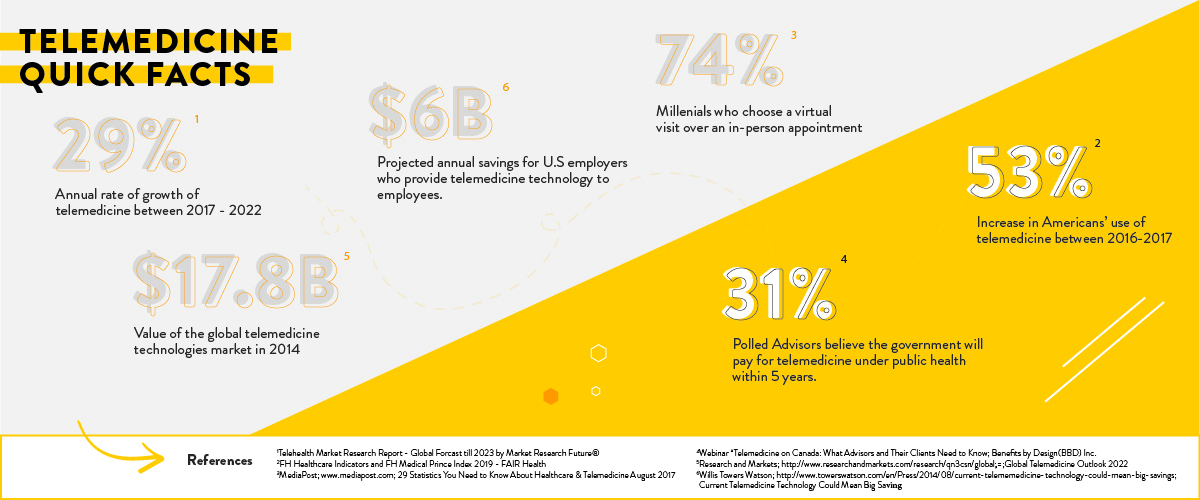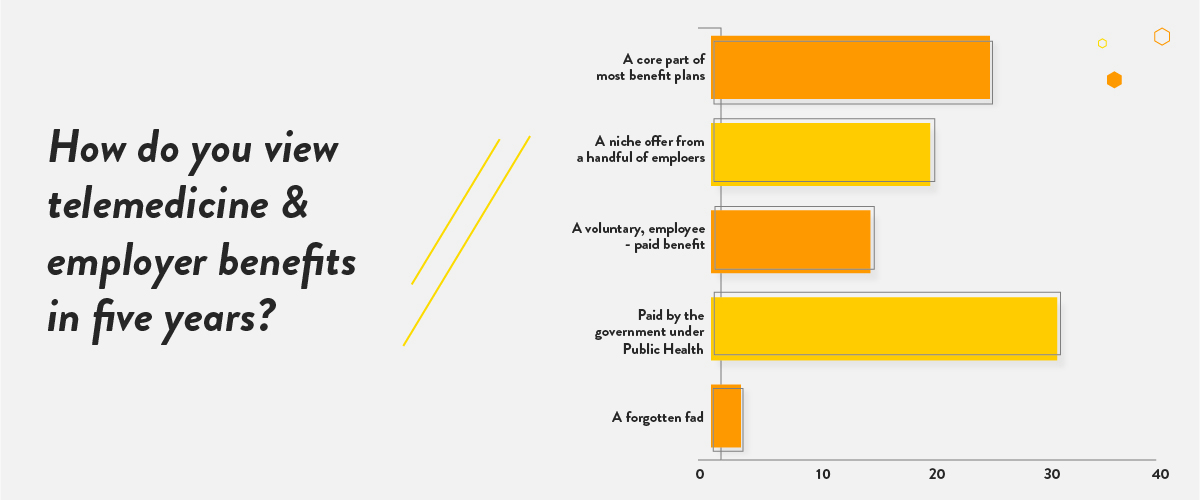Telemedicine in Canada: What it is, Where It’s Going, and Why it Matters
By: Benefits by Design | Tuesday April 16, 2019
Updated : Friday April 12, 2024
Healthcare at your fingertips? It’s not that far away.
New healthcare technologies are emerging every day. These technologies have a significant impact on a person’s life (consider 3D-printed replacement organs, smart inhalers, better prosthetics). There is one that might just be bringing health services to your home.
What is Telemedicine?
Telemedicine, sometimes referred to as telehealth, is a technology that allows the remote delivery of clinical healthcare services.
It encompasses a wide distribution of services, including healthcare visits, physiotherapy, psychotherapy, and even dentistry! As an industry, it is poised to change the way people interact with their physicians, receive care, and get their prescriptions.
There are three common types of telemedicine: Interactive Medicine (live video chat), Store and Forward (file sharing), and Remote Patient Monitoring (using mobile medical devices).
Is Telehealth Something Different?
The two terms are used interchangeably, although they mean slightly different things.
Telehealth includes a broad range of technologies and services to provide patient care and improve healthcare delivery. Generally, telehealth encompasses more solutions. As an example, telehealth could include provider training, administrative meetings, continuing medical education, and clinical services.
Telemedicine is a subset of telehealth that refers to providing health care services and education through telecommunications. Examples of this service would include follow-up visits, management of chronic conditions, consultations, and other clinical services provided over secure video and audio connections.
How Does Telehealth Help Working Canadians?
In light of the recent COVID-19 pandemic, we’ve seen telehealth:
Increase access to care.
Telehealth is particularly useful in rural areas with few available healthcare providers. Telehealth reduces wait times and increases service availability. After all, if you could consult a healthcare provider from your own home – wouldn’t you? The more Canadians receiving better access to healthcare, the better Canada becomes.
Relieve stress on the Canadian healthcare system.
Canadians have one of the highest wait times to see a physician in the world. 1 out of 5 Canadians reporting waiting seven or more days to see a family doctor.
The increased ease of physician access and availability through telehealth reduces wait times in doctor’s offices.
Provide the same level of care at a fraction of the cost.
A virtual visit generally costs less than an in-person visit. Though Canadian healthcare is free, it’s important to remember that “free” doesn’t always mean free. Canadian taxpayer’s dollars go towards paying for our healthcare system, so less expensive doctor’s visits free that valuable taxpayer money for other pursuits important to Canadians.
Enable continuous and ongoing care.
Telehealth isn’t likely to become a replacement for in-person doctor’s visits entirely, but will work in tandem with them. Doctors will be able to prescribe medications or exercises and use telehealth services to monitor adherence, share information, or adjust treatments between in-person visits. In turn, this will provide better patient outcomes and a level of continuous care that three-week wait times can’t match.
Telehealth Services in Employee Benefits
Increasingly, telehealth services are becoming a part of an employee benefits plan. For example, Green Shield Canada (GSC) has several digital health solutions designed to provide greater access and engagement between employees and their health benefits, such as MindBeacon or Phzio. These digital solutions focus primarily on acute, non-urgent care.
An increasing number of services are extending to ongoing, chronic care and disease management. These trends were discussed at length on a recent webinar we held with Tim Clarke, President tc Health Consulting Inc., called, “Telemedicine in Canada: What Advisors and Their Clients Need to Know.“
The Benefits of Telemedicine
Telemedicine is quickly becoming an emerging trend in the group benefits industry for a few reasons:
- Improves accessibility. The remote service delivery allows access to healthcare services from almost anywhere. This brings a higher level of access to care and more convenience for the user.
- Costs less. A virtual visit will generally cost less than an in-person visit. Especially when you factor in additional time spent driving to and from the Doctor’s office and money spent on gas.
- Faster access to services. In a country like Canada, which has one of the longest wait times to see a Doctor in the world, it’s far quicker to whip out your phone and use a virtual care for a consultation than it would be to sit in a waiting room.

Quick note – Although telemedicine provides these benefits, these services work best as a complement to in-person care, rather than a replacement entirely. It shouldn’t be putting Doctors out of jobs, but improving their ability to interact with and treat their patients! As Tim Clarke, President of tc Health Consulting Inc., said on our recent webinar:
Telemedicine allows continuous care to a patient by monitoring progress and providing additional information.
Telemedicine in Canada
While the virtual care industry is still new, and uptake in Canada is slower than originally thought, we don’t anticipate it going anywhere (quite the opposite, in fact). Questions remain as to exactly who or what will be responsible for the costs in the future.
It’s unclear whether the responsibility for providing access to these services falls on employers, Insurers, or the government. Advisors share their opinion on where telemedicine will be in five years as it relates to employee benefits. Here’s what they said:

As you can see, telemedicine is still in its infancy. It’s not easy to predict what kind of effect it will have on healthcare in Canada, but one thing is sure: it will have an impact.


